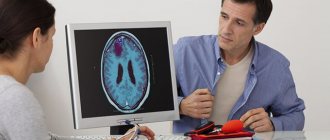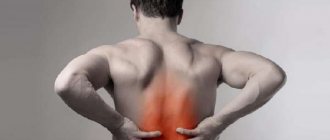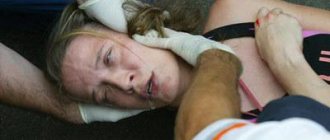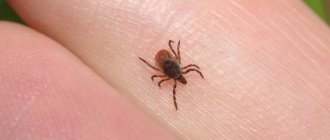Ganglionitis of the pterygopalatine ganglion - inflammatory lesion of the pterygopalatine nerve ganglion, predominantly of infectious etiology. Ganglionitis of the pterygopalatine ganglion is manifested by painful attacks in the affected half of the face, which are accompanied by vegetative symptoms (lacrimation, redness of the skin, swelling, salivation). Diagnosis of the disease is based on its clinical picture and the exclusion of other causes of facial pain. Ganglionitis of the pterygopalatine ganglion is treated with the complex use of analgesics, anti-inflammatory, antibacterial, ganglion-blocking and antiallergic drugs; lubricating the nasal cavity with a solution of dicaine; physiotherapeutic agents (UHF, electrophoresis, DDT, mud therapy).
Pterygopalatine neuralgia as an inflammatory component of neuralgia
Pterygopalatine neuralgia, as we have already written, is also called ganglionitis of the pterygopalatine ganglion, which indicates the inflammatory component of neuralgia - since all inflammatory diagnoses have the ending “-itis”. Ganglionitis is a disease that is dealt with first by dentists and then by neurologists, and the manifestations of the disease are combined into one “neurostomatological” syndrome.
Cranial nerves - pterygopalatine ganglion
Ganglionitis was discovered by an American doctor and is called Slader syndrome . This syndrome was described quite late - in 1908, only when such sciences as neurology, physiology of the central and peripheral nervous system, as well as the art of dissection were highly developed.
Diagnostics
For diagnosis, only the clinical picture and patient complaints are used. No tests are performed to confirm the diagnosis. It is imperative to carry out differential diagnosis with diseases such as:
- Neuritis of the somatic nerve.
- Syringomyelia.
- Meningoradiculitis.
- Neurovascular syndromes.
When diagnosing, consultations with a neurologist, dentist, or ENT specialist are required. Otoscopy and pharyngoscopy may be required, and sometimes x-ray diagnostics are prescribed.
Ganglion structure
The pterygopalatine ganglion lies “at the junction” of many “roads” of the peripheral nervous system. This determines the variability of clinical manifestations. It has the following parts:
- Sensitive somatic fibers from the maxillary nerve, carrying innervation from the oral mucosa, gums, cheeks;
- From the facial nerve - parasympathetic fibers that affect secretion and taste;
- From the carotid plexus - the internal carotid artery - sympathetic fibers.
In addition to these parts, which connect the ganglion with the facial and trigeminal nerve systems, the pterygopalatine ganglion is connected to a significant extent with the sympathetic ganglia and other ganglia, for example, the auricular and ciliary ganglia.
Such a close relationship allows the pterygopalatine node to respond sensitively to all processes occurring in the vessels and nerves of the head and neck.
Complications
Any pathologies associated with the nervous system leave a mark. The main complication of ganglionitis is postherpetic neuralgia. It is characterized by a strong burning sensation in the area of damage. It intensifies with palpation and any other contact, for example, with water, a towel, etc. There have been cases when such a complication tormented patients for 2-3 years after the course of therapy.
Sometimes there remains a slight weakening of muscle tissue in the place where the pathology was localized. The consequences can last a lifetime. In the absence of treatment, patients developed zoster myelitis and encephalitis.
Causes of development of pterygopalatine neuralgia (ganglionitis)
- Pathology of ENT organs. Everyone knows such diseases of the sinuses of the skull as sinusitis and frontal sinusitis. There is also inflammation of the ethmoid labyrinth - ethmoiditis. Since the pterygopalatine ganglion is close to these structures, inflammation can also affect it;
- Odontogenic mechanism of disease development: carious teeth, pulpitis, periodontitis are often the cause of the lesion;
Treat pulpitis on time - watch your teeth, otherwise ganglionitis may become a consequence.
- Injuries of the maxillofacial area, consequences of fractures of the zygomatic bones;
- Chronic intoxication: drinking alcohol, smoking, overwork, chronic lack of sleep, stress, loud noise, all processes that can disrupt the balance of excitation - inhibition in the nervous system can also trigger the development of this disease;
- This neuralgia can also be caused by tumors that form in the maxillary space, curvature of the nasal turbinates and septum, as a consequence of injuries. In addition, irritation of the ganglion can be caused by viral infections, herpes, local purulent diseases - follicular and lacunar tonsillitis, retropharyngeal and peripharyngeal abscess.
Follicular tonsillitis
Diagnostics
Inflammation of the nerve ganglion is diagnosed by a neurologist based on:
- patient complaints of pain;
- vasomotor and neurotrophic disorders;
- sensitivity disorders;
- other specific symptoms.
In addition, instrumental methods are used:
- radiography of the spine;
- electromyography;
- Ultrasound of the abdominal and pelvic organs;
- Ultrasound of the prostate and others.
To identify the causative agent of the infectious process, serological studies are carried out.
Since the pain syndrome due to inflammation of the nerve ganglion is nonspecific, many patients mistake the symptoms of pelvic postherpetic ganglioneuritis for gynecological pathology and seek treatment from.
Ganglion damage is differentiated from funicular myelosis, spinal tumor, neurosis, and so on.
How ganglionitis manifests itself, symptoms of ganglionitis
The classic sign, as with other neuralgia, is sharp, severe, short pain, similar to a lightning strike. They can be localized in various parts of the face: most often, pain occurs in the orbit, around the eye, at the base of the nasal bones. Sometimes shooting pains occur in the upper jaw (on one side), but sometimes sharp, strong attacks are possible in the teeth of the lower jaw or several teeth at once.
Many describe the pain as “bursting”, it is so strong.
In addition, due to the interaction of the ganglion with surrounding structures, sharp attacks of pain can occur in the ear, neck, back of the head, and temporal zone. In some cases, shooting pains can even reach the shoulder blade, the back of the head and, in some circumstances, even radiate to the hand.
Such localization of pain can be quite real with ganglonitis
A characteristic feature of pterygopalatine neuralgia are signs of autonomic dysfunction that accompany a painful attack. This “vegetative storm” can be manifested by the following symptoms:
- Redness or paleness of one half of the face, which is especially noticeable to others;
- Violation of tissue trophism, the appearance of swelling;
- Excessive secretion due to the involvement of parasympathetic branches: increased lacrimation from one eye on the affected side, discharge of watery secretion from one nostril (also on the affected side);
- Hypersalivation is increased salivation, and, as a rule, on one side of the oral cavity - on the affected side. During an attack, saliva can be released so much that it comes out “a mouth full.” If the patient uses a towel, it must be changed very often;
- Sometimes patients are even bothered by asthma attacks;
- Since the pterygopalatine ganglion contains fibers of the facial nerve, taste distortion is possible. As a rule, there is a feeling of bitterness, especially at the base of the tongue and its back.
- Since a large number of autonomic fibers are involved, general reactions are possible: collapsed states, fainting, and possible hypertensive crises.
Separately, we can distinguish “ophthalmic” symptoms: if they prevail over pain, the patient may first see an ophthalmologist. These signs include:
- Mild exophthalmos – protrusion of one eyeball on the affected side, which is associated with an increase in intraocular pressure;
The photo shows mild exophthalmos
- Photophobia is a symptom that is associated with dilation of the pupil on the affected side (due to the fact that a lot of light enters the retina); miosis occurs much less often - that is, narrowing of the pupil;
- Edema of the eyelid, lacrimation, blepharospasm, and conjunctival hyperemia may occur. In this case, an erroneous diagnosis of “conjunctivitis” is almost always made, and drops and antibiotics are prescribed. Of course, this does not lead to any noticeable result.
As a rule, an attack lasts no more than a few hours, but sometimes pain and vegetative paroxysms can last up to several days.
Like other attacks of cranial neuralgia, the onset of pain is typical at night, which can be the cause of persistent insomnia.
There is a principle of “emergency diagnosis”: if, during painful attacks, the posterior wall of the nasal cavity is irrigated with a solution of adrenaline along with an anesthetic, for example lidocaine. Previously, a solution of cocaine was used for this purpose.
The course of the disease is quite long; once it begins, attacks with varying frequency can bother a person for a number of months and even a number of years.
Ulcers
Ganglionitis is easy to identify in the most difficult cases of the disease, when ulcers appear on the affected area of the skin, and internal organs lose their functionality due to damage to the nerve nodes. Muscles located in the area of inflammation also undergo degeneration. They weaken and lose their tone. The joints lose their mobility, which is why the patient's reflex speed is reduced. Patients often complain of heart problems and angina, but this is caused by inflammation in the area of the stellate ganglion, which creates false secondary complaints.
How to treat ganglionitis
Treatment during acute pain involves:
- Lubrication or irrigation of the posterior sections of the nasal cavity, the area of the choanae with an anesthetic: novocaine, lidocaine;
- To relieve severe vegetative symptoms, ganglion blockers are used: arfonade, pyrylene, pentamine, benzohexonium. They can be administered intramuscularly;
One of the ganglion blockers is pentamin.
- In the event that the activity of the parasympathetic departments is pronounced, then drugs that reduce secretion, such as platyphylline, are used;
- Also, if the doctor has the skills (for example, the patient is in the department of maxillofacial surgery, or ENT), then it is possible to block the pterygopalatine node;
- Sometimes the use of desensitizing, antiallergic drugs, for example, antihistamines (betahistine, suprastin), has a good effect;
- A good effect is also possible with the administration of tranquilizing drugs, such as Relanium, Sibazon.
Prevention
The basis for the prevention of ganglionitis includes timely and correct treatment, prevention of the development of viral diseases.
- You should lead a healthy lifestyle and give up bad habits, do not eat a lot of fatty and salty foods.
- Every day you need to exercise. Morning jogging will not be superfluous either.
- Hardening strengthens the immune system well, but don’t immediately douse yourself with ice water. You need to start gradually with light douches in the bath, with rubbing your limbs with a cold and wet towel, and then you can gradually move on to douches in the fresh air, but first only in the warm season.
- Don't forget about a hat during the cold season. After all, no hairstyle can be more valuable than your own health, and without a hat in winter you can get sick with more serious diseases.
- To prevent the disease, especially in spring and autumn, you need to strengthen your immune system with vitamins and eat more fruits and vegetables.
It is also important to get vaccinated in advance; it will provide the body with lasting immunity against this disease. During a disease outbreak, you must wear a special protective mask.
Treatment of ganglionitis during the interictal period
After stopping the attack, you need to start looking for the reasons that led to the development of acute pain: you need to treat inflammation in the sinuses of the skull (treat sinusitis, sinusitis, ethmoiditis, visit a dentist, have your teeth sanitized). Antibiotics and drugs that enhance immunity are used.
During the interictal period, taking anticonvulsants (primarily carbamazepine), as well as antidepressants, except amitriptyline, has a good effect. Electrophoresis of anesthetics (Novocaine), the use of physical therapy (UHF), and diadynamic currents have a good effect in preventing an attack.
Any neurologist, after treating ganglionitis, will refer the patient to UHF procedures.
Treatment of this disease should be carried out taking into account the improvement of the general background of the body: taking multivitamins, doing physical exercise, correcting blood pressure, taking medications that reduce the manifestations of atherosclerosis. An important factor that reduces the risk of developing this neuralgia is proper cerebral circulation.
Among the medications used in treatment, neurotropic B vitamins (thiamine, pyridoxine, cyanocobalamin) are taken. A modern complex preparation that allows you to combine these vitamins is Milgamma Compositum.
In addition, the use of neuroprotectors (piracetam, Nootropil) and drugs that improve cerebral circulation is indicated.
In case of treatment-resistant, persistent and severe pain, radiofrequency destruction of this node can be used, which significantly reduces the frequency and intensity of pain impulses. Of course, it is not recommended to destroy such an important node, since you can get a lot of unforeseen phenomena, such as dry eyes, dry nasal mucosa and much more.
An alternative option is X-ray therapy, which uses a directed beam of radiation.
In conclusion, it is worth saying that when such symptoms appear, as is clear from the article, the first doctors - “narrow specialists” to whom the patient turns are first otolaryngologists, then dentists, and in rare cases - ophthalmologists. The situation when a patient goes straight to a neurologist from the very beginning is from the realm of clinical casuistry. It is also worth recalling the general contraindications for neuralgia.
Almost always, an ENT doctor, and especially a dentist, can find your pathology and begin to treat it as effectively as possible and, unfortunately, in our time, as expensively as possible.
Therefore, patients come to a neurologist as a result of the powerlessness of other specialists, “football”, and, as a rule, with an empty wallet. If such unusual facial pain occurs, take the time to visit a competent neurologist and carefully tell him about your complaints.
Diagnostics
Differential clarification of the diagnosis is very difficult; the cause of inflammation can be determined based on the clinical symptoms and complaints of the patient.
There are no specific tests or examinations that completely confirm this type of inflammation.
The patient needs to receive neurological, dental and ENT consultation.
Pharyngoscopy and otoscopy are often required, and in some cases, x-rays.
A comparative analysis is carried out with somatic neuritis, syringomyelia, meningoradiculitis, and neurovascular pathologies.
If ganglionitis has affected the lower thoracic or lumbar nerve nodes, diseases of the peritoneal organs should be excluded, and with upper thoracic or cervical inflammation, heart diseases should be excluded.
Femoral nerve
Pathology that damages the external cutaneous nerve of the thigh is called Roth disease. With this disease, the patient feels pain and burning in the part of the body where the nerve ending is located.
The front outer part of the thigh becomes numb. In some patients, discomfort occurs very suddenly and unexpectedly, but quickly passes. However, often neuralgia of this type becomes chronic, and then the painful sensations persist for a very long time.
The cause of the development of pathology of the external nerve of the thigh can be diabetes mellitus, vascular diseases, poisoning with low-quality alcohol, mechanical compression of the nerve ending with a bandage.
The trigeminal nerve is located in the front of the skull, which is why it is often called the facial nerve. It provides facial sensitivity and oral motor function. The pair of nerves forms the Latin letter V, and consists of the orbital, maxillary and mandibular branches. Thanks to the normal functioning of such nerve endings, a person can chew food, talk, and experience tactile sensations. The facial nerve is directly connected to the thalamus and spinal cord.
Doctors identify several causes for the development of trigeminal neuralgia. They can be divided into two main groups, namely:
- Factors of central genesis. The symptoms of neuralgia appear very sharply and unexpectedly, and do not last long. After a few seconds or minutes, the pain completely disappears, but after a while it may appear again. The cause of this disease is pain paroxysm of cortical or subcortical origin.
- Factors of peripheral genesis. In such cases, neuralgia is a consequence of the development of a viral, infectious, toxic disease. The trigeminal nerve may also be compressed by enlarged blood vessels.
Treatment of facial neuralgia directly depends on the cause of the pathology. That is why it is so important to conduct a complete examination of the patient’s body and make the correct diagnosis.
Symptoms
The main symptom of damage to the trigeminal nerve is acute short-term pain. It is usually localized in the facial area - exactly where the nerve endings pass. In addition, the patient may experience accompanying symptoms:
- Profuse lacrimation;
- Uncontrolled secretion of large amounts of saliva;
- Redness of the facial skin.
If you touch certain points on the face, the patient will feel severe pain. Discomfort is also felt when chewing, talking, shaving. If the disease affects the mandibular branch of the facial nerve, the patient may experience a disturbance in the motor function of the masticatory muscles, manifested by spasms, atrophy or involuntary twitching.
Trigeminal neuralgia can last for years. In this case, the patient suffers from time to time from exacerbation of the disease, but it quickly passes and a period of remission begins. Treatment of such a disease depends on the individual characteristics of the development of the pathology and the factors that provoke it.
Symptoms
The presence and severity of symptoms will be dictated by the location of the inflammatory process. However, the following clinical manifestations are considered common to all forms of the disease:
- pronounced paroxysmal pain;
- severe itching of the skin located above the affected node;
- swelling and redness of the skin area;
- increased sensitivity to external stimuli;
- profuse sweating;
- local and general increase in temperature indicators;
- malaise, weakness and weakness;
- muscle atrophy and limited joint mobility.
Ganglionitis of the pterygopalatine ganglion is expressed in:
- spread of pain in the eye sockets, jaws, nasal cavity and temples, auricle and back of the head, forearm and hand;
- swelling of the face;
- increased salivation and lacrimation;
- discharge of mucus from the nostril corresponding to the side of the lesion.
An attack of severe symptoms can last from 10 minutes to several days. Patients also complain of increased intensity of symptoms at night.
Ganglionitis of the ear node is represented by the following symptoms:
- paroxysmal pain spreading to the temples and back of the head, neck and chest, forearm and upper limb;
- noise and ringing in the sore ear;
- profuse salivation.
Inflammatory damage to the ciliary node is characterized by:
- “falling out” of the eyes from their sockets;
- irradiation of pain to the frontal part, root of the nose and temporal region;
- increased sensitivity to bright light;
- swelling of the eyelids;
- exophthalmos.
Symptoms of the Gasserian node form of the disease may include:
- photophobia and;
- increase in body temperature;
- paresthesia;
- muscle weakness;
- body aches;
- the appearance of vesicle-type rashes;
- swelling of the eyes.
When the stellate ganglion becomes inflamed, the following is observed:
- heart rate disturbance;
- heart pain;
- numbness of the upper limb.
The submandibular and sublingual appearance has the following features:
- localization of pain in the tongue spreading to the lower jaw, back of the head, neck and temples;
- inability to move the jaw;
- discomfort while eating;
- increased saliva secretion;
- coating of the tongue with a white coating;
- swelling of soft tissues.
With cervical ganglionitis, patients complain of:
- pale skin;
- nasal congestion;
- tissue hypertrophy;
- an increase in the number of fine wrinkles;
- redness of the eyeball and part of the face on the affected side;
- aching pain in the neck, back of the head and shoulder girdle.
Clinical manifestations of geniculate ganglion pathology may include:
- general malaise;
- herpetic rashes around the ear;
- attacks of severe dizziness;
- decreased hearing acuity;
- paresis of the facial or trigeminal nerve;
- formation of herpetic papules on the tonsils and soft palate;
- horizontal nystagmus;
- paresis of facial muscles.
It is also worth noting that the muscles located near the affected node begin to atrophy and lose their mobility.
Etiology
Inflammatory lesions of the ganglia do not develop spontaneously or for no apparent reason. In the vast majority of cases, the following infections are the triggering factors:
Also, the causes of ganglionitis can be presented:
- wide range of injuries;
- heavy body, having a toxic, narcotic, or medicinal nature;
- long-term use of corticosteroids;
- benign or malignant neoplasms, regardless of etiology and location;
- inflammation of the tissues of the reproductive system organs in females;
- flow, and;
- chronic course or, or, and also;
- metabolic disorders, for example, with.
Extremely rare provocateurs of this disease are:
- weather conditions;
- climatic factors;
- CNS injuries;
- mental disorders.
Glossopharyngeal nerve
The pterygopalatine ganglion is in direct contact with the second branch of the trigeminal nerve. This parasympathetic nerve formation can also be affected by neuralgia. The cause of this disease is most often acute or chronic inflammation of the throat and other ENT organs.
The main symptoms of neuralgia of the pterygopalatine ganglion can be considered:
- Sharp and piercing pain localized in the eyes, nose, teeth. The discomfort gradually intensifies, and the pain may radiate to the temporal area or neck.
- Tearing and drooling.
- Redness and swelling of the eyes.
- Blepharospasm.
As a rule, the symptoms of neuralgia occur very suddenly, at night. It is very difficult to endure such pain, but it does not last long at all - from several hours to a day. Exacerbation of pathology is replaced by remission. To protect yourself from this type of neuralgia, avoid extreme fatigue, emotional overload, colds, stop drinking alcohol and other bad habits.
The glossopharyngeal nerve belongs to the group of cranial nerves. This formation provides sensitivity to the palate and tonsils, the back of the tongue, and is responsible for the motor activity of the pharyngeal muscles. Neuralgia of the glossopharyngeal nerve usually occurs as a complication after an infectious disease or injury to the tonsils. A tumor may also be the cause of the development of pathology.
- Unilateral pain localized in the palate, root of the tongue, ear.
- Unpleasant sensations during swallowing, yawning, coughing.
- Dry throat.
- Changing the taste of familiar foods. The sense of taste may disappear altogether or the food may seem bitter.
An attack of glossopharyngeal neuralgia can occur completely unexpectedly. Often, an exacerbation of the pathology is provoked by a strong cough or normal conversation.
Clinical picture
With G., there is a polymorphism of symptoms characteristic of the pathology of the. n. p.: paresthesia, burning pain that can spread to the entire half of the body, painful itching in the area related to the affected ganglion. Pain appears on palpation of the spinous processes of the vertebrae (especially with ganglioradiculitis). Often the pain occurs in attacks. There may be functional disorders and pain from the internal organs innervated by the affected nodes. Skin-trophic disorders develop: changes in skin color and pigmentation, thinning and ulceration of the skin, swelling of the subcutaneous tissue; Regional sweating and thermoregulation are impaired. From the motor sphere - regional muscle atrophy, changes in muscle tone, contractures and ankylosis of joints, areflexia. When the upper cervical sympathetic node is affected, all these changes are observed in the head, face, and neck. If the stellate ganglion is affected, there is pseudoangina syndrome and pain in the arm and upper chest. If the lower thoracic and lumbar nodes are affected, there is a violation of the vegetative-trophic innervation of the lower torso and legs and dysfunction of the abdominal and pelvic organs.












